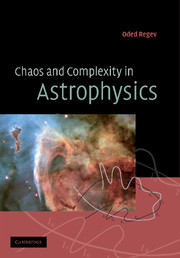Book contents
- Frontmatter
- Contents
- Preface
- Acknowledgements
- Part I Dynamical systems – general
- 1 Introduction to Part I
- 2 Astrophysical examples
- 3 Mathematical properties of dynamical systems
- 4 Properties of chaotic dynamics
- 5 Analysis of time series
- 6 Regular and irregular motion in Hamiltonian systems
- 7 Extended systems – instabilities and patterns
- Part II Astrophysical applications
- References
- Index
6 - Regular and irregular motion in Hamiltonian systems
Published online by Cambridge University Press: 14 January 2010
- Frontmatter
- Contents
- Preface
- Acknowledgements
- Part I Dynamical systems – general
- 1 Introduction to Part I
- 2 Astrophysical examples
- 3 Mathematical properties of dynamical systems
- 4 Properties of chaotic dynamics
- 5 Analysis of time series
- 6 Regular and irregular motion in Hamiltonian systems
- 7 Extended systems – instabilities and patterns
- Part II Astrophysical applications
- References
- Index
Summary
There is no limit to how complicated things can get, on account of one thing always leading to another.
E. B. White, Quo Vadimus?Hamiltonian systems constitute a very important subclass of dynamical systems. The basic model systems of classical mechanics – point masses moving in external potentials (modelling, e.g., planets in the Solar System, oscillating bodies attached to springs etc.) – are among the simplest Hamiltonian systems. The Lagrangian and Hamiltonian formalism of Newtonian dynamics provides the mathematical framework for the study of such (literally) dynamical systems. As these were the first dynamical systems to be studied extensively, the subject owes its name to them.
The problems of classical mechanics are by no means the only examples of Hamiltonian systems. Hamiltonian maps and differential systems also arise in the study of such diverse physical systems as propagating waves, fluids and plasmas, electric circuits etc. In addition, the Hamiltonian formulation is central to such important branches of physics as statistical mechanics, field theory and, most notably, quantum mechanics. It is thus important to understand the fundamental properties of classical Hamiltonian systems and the possibility of chaotic behaviour in them.
A basic attribute of Hamiltonian systems is that they are conservative. As we have already defined, a dynamical system is conservative if it preserves phase volume. Volume preservation in Hamiltonian systems endows them with special properties. One such important feature is that they do not have attractors. As we have seen in Chapter 4, the existence of strange attractors in dissipative systems is a primary characteristic of chaos.
Information
- Type
- Chapter
- Information
- Chaos and Complexity in Astrophysics , pp. 168 - 200Publisher: Cambridge University PressPrint publication year: 2006
